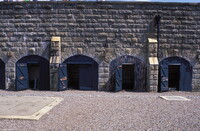| dc.coverage.spatial | Site: Halifax, Nova Scotia, Canada | en_US |
| dc.coverage.temporal | 1828-1856 (creation) | en_US |
| dc.creator | unknown (Canadian) | en_US |
| dc.date | 1828-1856 | en_US |
| dc.date.accessioned | 2013-05-10T17:11:06Z | |
| dc.date.available | 2013-05-10T17:11:06Z | |
| dc.date.issued | 1828-1856 | en_US |
| dc.identifier | 215935 | en_US |
| dc.identifier.other | archrefid: 264 | en_US |
| dc.identifier.uri | http://hdl.handle.net/1721.3/123572 | |
| dc.description | Interior defense wall; Citadel Hill is a glacial drumlin located on the Halifax Peninsula. It measures approximately 120 feet above sea level and affords a commanding view of the entrance to Halifax Harbour, as well as nearby George's Island and McNabs Island. A series of 4 different defensive fortifications have occupied the summit of Citadel Hill since 1749. The current star-shaped fortress, or citadel, is formally known as Fort George and was completed in 1856, following 28 years of construction. This massive masonry-construction fort was designed to repel a land-based attack by United States forces and was inspired by the designs of Louis XIV's commissary of fortifications Sébastien Le Prestre, Seigneur de Vauban. Source: Wikipedia; http://en.wikipedia.org/wiki/Main_Page (accessed 2/8/2008) | en_US |
| dc.format.medium | stone; granite | en_US |
| dc.rights | © Scott Gilchrist, Archivision, Inc. | en_US |
| dc.subject | architectural exteriors | en_US |
| dc.subject | military | en_US |
| dc.subject | war | en_US |
| dc.subject | British Colonial | en_US |
| dc.title | Citadel Hill, Halifax | en_US |
| dc.title.alternative | Fort George | en_US |
| dc.type | image | en_US |
| dc.rights.access | Licensed for educational and research use by the MIT community only | en_US |
| dc.identifier.vendorcode | 1A2-C-H-HC-B6 | en_US |
| vra.culturalContext | Canadian | en_US |
| vra.technique | construction (assembling) | en_US |
| vra.worktype | fortification | en_US |
| dc.contributor.display | unknown (Canadian) | en_US |


